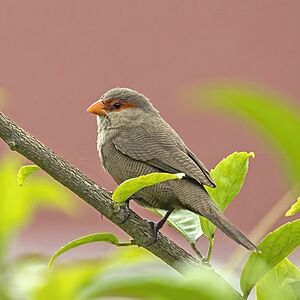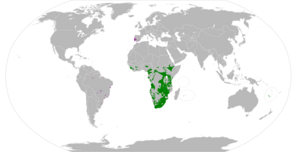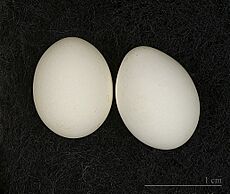Common waxbill facts for kids
Quick facts for kids Common waxbill |
|
|---|---|
 |
|
| E. a. jagoensis São Tomé and Príncipe |
|
| Conservation status | |
| Scientific classification | |
 |
|
| Synonyms | |
|
Loxia astrild Linnaeus, 1758 |
The common waxbill (Estrilda astrild) is a small, colorful bird. It is also known as the St Helena waxbill. This bird belongs to the estrildid finch family. It is originally from sub-Saharan Africa. However, you can now find it in many other parts of the world. Common waxbills are popular pets and are easy to care for.
Contents
Meet the Common Waxbill: What Does It Look Like?
The common waxbill is a small bird. It is about 4 to 5 inches long. Its wingspan is around 4.5 inches. The bird weighs about 3/5 to 3/4 of an ounce. It has a slim body. Its wings are short and rounded. The tail is long and tapers off.
Why Is It Called a Waxbill?
Adult common waxbills have a bright red beak. It looks like the red sealing wax used in old letters. This is how the bird got its name!
Feathers and Colors
Most of the bird's feathers are grey-brown. They have fine dark brown stripes. A red stripe goes through its eye. Its cheeks and throat are whitish. Sometimes, the belly has a pinkish or reddish stripe. This depends on the specific type of waxbill. The lower back is brown. The tail and vent (area under the tail) are dark.
Males, Females, and Young Birds
Female waxbills look a lot like males. But their colors are usually lighter. They have less red on their belly. Young birds are even duller. They have little or no red on their belly. Their dark stripes are fainter. Young waxbills also have a black beak.
Similar Birds You Might See
Some other birds look similar to the common waxbill. These include the black-rumped, crimson-rumped, and black-lored waxbills. You can tell them apart by small differences. For example, the black-rumped waxbill has a black lower back. The crimson-rumped waxbill has a dark beak and a red lower back. The black-lored waxbill has a black stripe through its eye instead of red.
Sounds of the Waxbill
Common waxbills make many different sounds. They have twittering and buzzing calls. Their flight call is high-pitched and easy to recognize. Their simple song sounds harsh and nasal. It usually ends on a lower note.
Where Do Common Waxbills Live?
Common waxbills live in many places. They are found in their natural home and in new places.
Native Home: Africa
There are many different types (subspecies) of common waxbills. They live across much of Africa south of the Sahara desert. You can find them in East, Central, and Southern Africa. They avoid deserts or very thick forests. In West Africa, they are more common in places like Sierra Leone and Liberia.
Common waxbills like open areas with tall grass. They also like thick plants. You often see them near water, like in marshes or among reeds. They can be quite friendly. They will even visit gardens, parks, and farms.
New Homes Around the World
Many waxbills have escaped from cages. Others were set free on purpose. They have started new families in many warm places. These places must have enough grass seeds for them to eat.
Now, you can find them on many islands near Africa. These include Saint Helena, Mauritius, and Réunion. In Europe, they are common in Portugal and are spreading in Spain. Small groups also live on Madeira and Gran Canaria. In the Americas, they are found in Trinidad and parts of Brazil. In the Pacific, they live on New Caledonia and the Hawaiian Islands. In Spain, they are now often seen in big cities like Madrid and Barcelona.
Common Waxbill Behavior and Lifestyle
Common waxbills have interesting ways of living and raising their young.
Building Nests and Raising Chicks
The common waxbill builds a large, round nest. It is made of criss-crossed grass stems. The nest has a long, tube-like entrance pointing downwards. They usually build it in a hidden spot. This is often low down in thick plants. Sometimes, the male builds a smaller "cock's nest" on top. He might sleep there.
The female lays four to seven white eggs. Both parents take turns sitting on the eggs. This is called incubation. It lasts for 11 to 13 days. The young birds leave the nest (fledge) about 17 to 21 days after hatching. Both parents also help feed the baby birds. The time of year they breed changes depending on where they live.
Sometimes, other birds, like the pin-tailed whydah, lay their eggs in waxbill nests. This is called brood parasitism. In captivity, waxbills can have up to four groups of babies in a year.
What Do Waxbills Eat?
Common waxbills mostly eat grass and millet seeds. But they also eat insects sometimes. They eat more insects during the breeding season. This gives them extra protein for their growing chicks.
Guinea grasses (Panicum maximum) are very important for them. These plants have seeds all year round. Other important foods include crabgrass (Digitaria horizontalis) and Echinochloa species.
Waxbills usually look for food in large groups. These groups can have hundreds or even thousands of birds! They often cling to plant stems with their long claws. They pick seeds right from the flower heads. They also look for fallen seeds on the ground. Waxbills need to drink water often. This is because seeds do not contain much water.
Images for kids
-
feral adult on Gran Canaria, Canary Islands, Spain
-
Flock at iSimangaliso Wetland Park, KwaZulu Natal, South Africa







